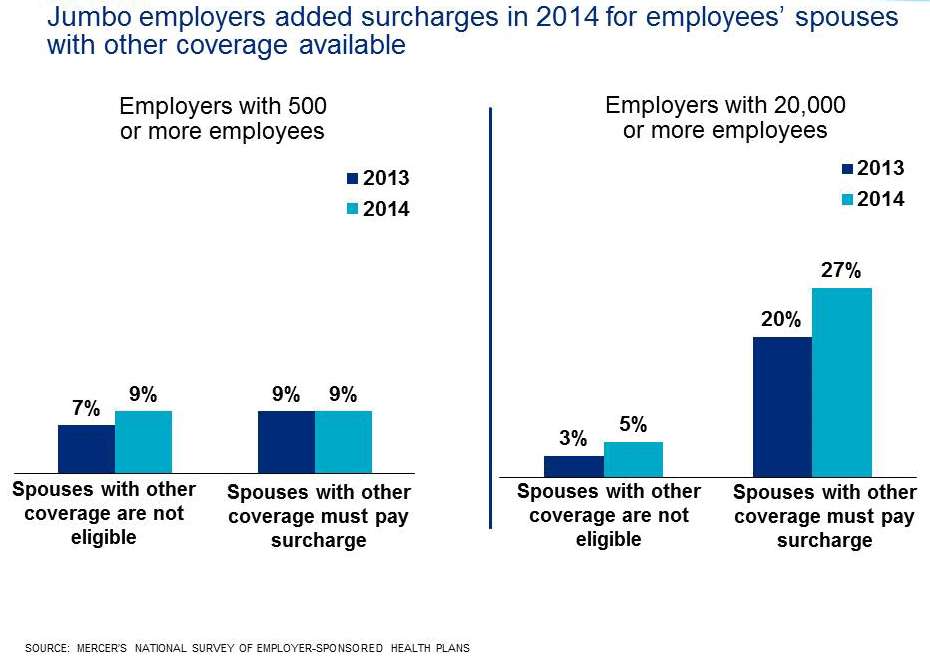Coverage for Spouses and Dependents Scaled Back
By 2017, most plan to add surcharges or exclude spouses when coverage available elsewhere
To better control rising health care costs and minimize the risk of triggering the Affordable Care Act's 2018 excise tax, over the next three years a growing number of employers will make significant changes in how they subsidize health care coverage for their employees’ spouses and dependents.
Results from the 2014 Towers Watson Health Care Changes Ahead Survey show that by 2017, 63 percent of midsize and large U.S. employers will add surcharges or exclude spouses from coverage when employer-sponsored health coverage is available elsewhere. The survey was fielded during July 2014 among employee benefit professionals from midsize to large U.S. companies that collectively employ 8.7 million workers.
“Health care coverage for spouses and dependents is a charged topic,” said Randall Abbott, a senior consultant for Towers Watson, in a statement announcing the findings. “Historically, virtually all large employers have offered and subsidized it, but it’s expensive. As employers seek to manage their expenditures, a growing number are rethinking their willingness to cover a working spouse who has a health benefit option elsewhere. The emphasis has been on increasing employee contributions or introducing surcharges, with a small percentage of employers actually excluding working spouses from coverage altogether.”
Results from an earlier survey, the Towers Watson/National Business Group on Health Employer Survey on Purchasing value in Health Care, provide more insight into the specific actions employers are already taking. Fielded between November 2013 and January 2014 among employers with at least 1,000 employees, the survey shows that in 2014:
- 49 percent of employers increased employee contributions for spouse and dependent coverage at a faster rate than for individual employee coverage.
- 24 percent implemented spouse coverage surcharges of about $100 per month or more when other coverage was available to the spouse. These surcharges increased the cost of spouse coverage for employees by $1,200 a year, on average, and at the high end, by more than $2,000 a year.
- 2 percent offered no subsidy at all for spouse coverage.
“These subsidy changes and surcharge levies are just some of the many changes employers continue to make to control costs,” said Abbott. “The overall goal is to manage costs and derive greater value for each dollar spent while also improving worker health, quality of care and health outcomes. The challenge for employers is that there is no single solution; rather, they must look across all program dimensions.”
Other Findings on Spousal/Dependent Coverage
According to Mercer's November 2014 National Survey of Employer-Sponsored Health Plans report, 9 percent of large employers now impose a surcharge on the premiums for spouses who have other coverage available, and another 9 percent make them ineligible for coverage altogether.
The median surcharge is an additional $100 per month, Mercer found.
The largest organizations, which tend to offer more generous coverage and can become “dependent magnets,” have moved the fastest to impose surcharges: 27 percent of employers with 20,000 or more employees did so in 2014, up from 20 percent in 2013. However, only 5 percent of these jumbo employers exclude spouses with other coverage.
Mercer’s survey included public and private organizations with 10 or more employees; 2,569 employers responded in 2014.

In addition, research findings released by consultancy Aon Hewitt in November 2014 confirm the shift toward reduced eligibility and subsidies for spouses and dependents among midsize and large U.S. employers. Among the findings:
- 58 percent of companies have completed a program audit of covered dependents to ensure only those who are eligible will remain on the plan.
- 52 percent of companies are considering using unitized pricing—where employees pay per person, and not individual versus family.
- 22 percent of companies have reduced subsidies for covered dependents, while 18 percent added a surcharge for adult dependents with access to other health coverage. Moreover, half of all companies are exploring such approaches over the next few years.
Stephen Miller, CEBS, is an online editor/manager for SHRM. Follow him on Twitter @SHRMsmiller.
Related SHRM Articles
- Larger Increases in Health Premiums Expected, SHRM Online Benefits, November 2014
- Employers Alter Health Plans to Drop Costs, Avoid Tax, SHRM Online Benefits, November 2014
- Surge in Employees’ Share of Health Costs, SHRM
Advertisement
An organization run by AI is not a futuristic concept. Such technology is already a part of many workplaces and will continue to shape the labor market and HR. Here's how employers and employees can successfully manage generative AI and other AI-powered systems.
Advertisement


